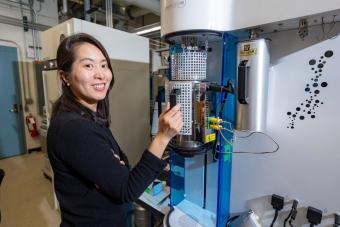Stephanie Kwon wins NSF CAREER Award for research to design new catalytic materials

Stephanie Kwon, assistant professor of chemical and biological engineering at Colorado School of Mines, has received a National Science Foundation CAREER Award for her work to design catalytic materials for carbon-carbon (C-C) coupling reactions.
Such carbon-carbon (C-C) coupling reactions are important to improve the fuel properties of biofuels, such as in upgrading bioethanol to longer chain hydrocarbons.
Kwon’s focus is on bottom-up designing catalysts to increase their effectiveness in converting raw biomass molecules to higher-value fuels and chemicals. The goal is to enhance the rate of chemical reactions, improve energy efficiency and ultimately, contribute to the future of sustainable biofuels.
The $656,791 award from NSF covers five years of research. Kwon also plans to integrate research results into classroom materials, provide research opportunities for students from historically underrepresented groups in STEM, showcase her lab to local K-12 female students and create educational videos distributed via social media to help researchers who are new to heterogeneous catalysis research.
Here, Kwon answers some questions about her research and how it could lead to the future of cleaner sustainable fuels.
Q: What is your latest research focused on?
Stephanie Kwon: My research group in general works on heterogeneous catalysis, designing catalytic materials for more sustainable chemical processes. Specifically for this CAREER Award, we are trying to design catalytic materials for C-C coupling chemistry, so building two carbon-carbon compounds and make it into something longer or into products. And those reactions are specifically very critical for upgrading biomass-derived compounds. As part of biomass products, we make very small products, like bioethanol or acetone. Those are small building blocks and are not the best materials to utilize for fuels. In my research group, we are trying to think about how we can upgrade those biomass-derived chemical products into something that is more valuable for the society.
Specifically, within this project we are trying to, from the bottom up, design materials more inspired by enzymes. So, we’re not doing any biochemistry here. But in a bio-enzymatic system, it’s not about the binding site that makes the transformation, but also the surrounding. It’s like a pocket structure that allows enzymes to be superior. Inspired by those understandings about enzymes, we’re trying to make solid catalysts that can have a very specific environment around the active site. We call it a bottom-up design of the environment around the active site to do the CC coupling chemistry in a more reactive and selective manner.
Q: What do you find most exciting about your research?
Kwon: The most exciting part about our research is that we take our very fundamental understanding of how molecules react and transfer itself into applying that knowledge into making a real impact in society by providing chemical reactions that are more sustainable.
Q: What is the potential impact of this work?
Kwon: Right now, we know how to make biomass, or ethanol, in a cheap and economic manner. But bioethanol is not the best fuel. For example, you don’t want to put bioethanol into your car; you need fuel. So, if you want to make biofuels out of bioethanol, this C-C coupling chemistry via aldol condensation is a process that could make it happen.
In a more scientific manner, we are trying to transform the way that we design catalytic material. Historically, what we would do is take something that is made from crystallization or take something that naturally occurs in abundance in nature. But what we are trying to do instead is now that we try to understand these molecular reactions, we do it in a bottom-up approach, and that way we can modify and design nanomaterials in a more precise manner.
Q: How does this research agenda inform your teaching?
Kwon: My classroom teaching is very application based. Often, undergraduate students might lose the point of why what they’re learning is important. In general, I try to give them a bigger picture about how those specific topics are relevant in real-life research. I teach reaction engineering and heterogenous catalysis and sustainable energy in such a way that I can bring in these topics to the classroom. Students get more excited about environmental catalysis moving away from its conventional role in petroleum and gas and how it’s moving into the future. These types of topics are critical in making things more sustainable.
With graduate students, I try to impart that we’re trying to solve the problem of how oil and gas is envisioned as only creating pollutants and destroying the environment. In fact, all the tools that we have learned out of the last 100 years of chemical engineering research can be directly applied to solve our environmental problems. So maybe we are the cause of the problem, but we may be the solution at the same time.




